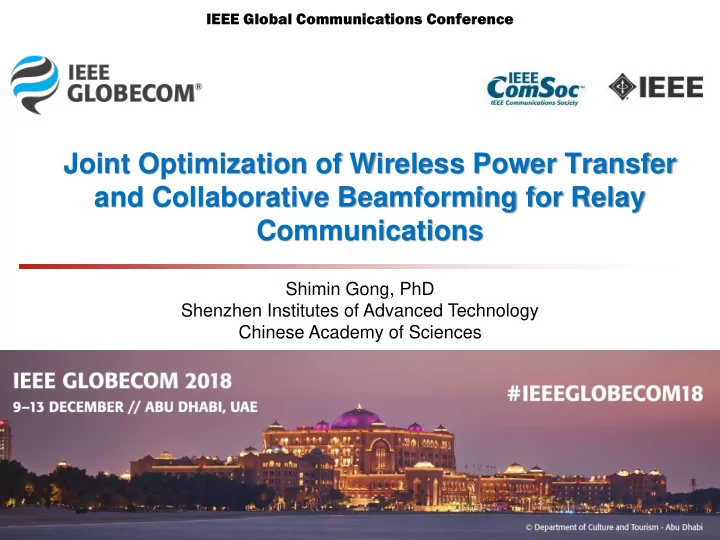

IEEE Global Communications Conference Joint Optimization of Wireless Power Transfer and Collaborative Beamforming for Relay Communications Shimin Gong, PhD Shenzhen Institutes of Advanced Technology Chinese Academy of Sciences
Outline ◼ Introduction ◼ System Model ◼ Robust Multi-Relay Transmission ◼ Numerical Results 2
Introduction Enhance information and power transfer I Beamforming Collaborative III Transmission Leverage diversity S imultaneous W ireless I nformation & II Power Splitting P ower Sustainable T ransfer scheduling 3
Introduction Power Splitting Scheme 1 − 𝜍𝑧 𝑆 Information Receiver 𝑧 𝑆 Power + Splitting Energy Antenna Receiver 𝜍𝑧 𝑆 noise 4
System Model 2 nd Hop: Relays → URx 1 st Hop: HAP → Relays U ser Rx SWIPT 𝐡 Relay 𝐴 𝐠 Hybrid AP Collaborative Cellular Relay Networks Network 5
System Model ◼ Energy Beamforming and Harvesting 𝐼 𝐱𝑡 + 𝜏 𝑜 𝐼 𝐗𝐠 𝑜 𝑧 𝑆 𝑜 = 𝑞 𝑢 𝐠 𝑜 𝑞 𝑜 ≤ 𝜃𝜍 𝑜 𝑞 𝑢 𝐠 𝑜 𝐗 = 𝐱𝐱 𝐼 , Beamforming Matrix 𝐱 , Beamforming Vector 𝑞 𝑢 , HAP Transmit Power 𝜃 , Energy Harvesting Efficiency 𝑡 , HAP Transmit Symbol 𝜍 𝑜 , Power Splitting Ratio 6
System Model ◼ Relays' Transmit Control Amplify-and-Forward 𝐼 𝐱𝑡 + 𝜏 𝑜 1 − 𝜍 𝑜 𝑞 𝑢 𝐠 𝑜 𝑞 𝑜 𝑦 𝑜 = Amplify Coefficient 𝐼 𝐗𝐠 𝑜 𝑂 0 + 1 − 𝜍 𝑜 𝑞 𝑢 𝐠 𝑜 𝑂 𝑂 𝐼 𝐱 𝑜 𝑡 + 𝑣 = 𝑦 𝑜 1 − 𝜍 𝑜 𝑞 𝑢 𝐠 𝑜 𝑦 𝑜 𝜏 𝑜 𝑜 + 𝑤 𝑒 URx Reception 𝑜=1 𝑜=1 Signal Noise 7
System Model ◼ Interference to Cellular Users 𝑂 2 𝜚 𝑛 = 𝑞 𝑜 𝑨 𝑜 𝑜=1 Channel Uncertainty Robust Interference ℙ 𝐴 ∈ 𝒬 𝐯 𝐴 , 𝐓 𝐴 Constraint 𝐯 𝐴 , First Order Moment 𝐴 ℙ 𝜚 𝑛 ≥ ത max 𝜚 ≤ 𝜂 𝐓 𝐴 , Second Order Moment ℙ∈𝒬 8
Robust Multi-Relay Transmission Highly Coupled 𝐲 ∘ 𝐳 𝐼 𝐡 2 URx Throughput 𝜍 𝑜 ,𝐱,𝑞 𝑜 𝑠 = log 1 + max 1 + 𝐲 𝑈 D 𝐡 ∘ 𝐡 𝐲 Maximization 𝐼 𝐗𝐠 𝑜 s. t. 0 ≤ 𝑞 𝑜 ≤ 𝜃𝑞 𝑢 𝜍 𝑜 𝐠 𝑜 Energy Constraint 𝐴 ℙ 𝜚 𝑛 ≥ ത max 𝜚 ≤ 𝜂 Interference Constraint ℙ∈𝒬 Non-Convex 𝐔𝐬 𝐗 ≤ 1, 𝐗 ≽ 0, and 0 ≤ 𝜍 𝑜 ≤ 1 ∘ , Hadamard Product D 𝐲 , Diagonal matrix with the diagonal given by the vector 𝐲 𝐳 = 𝑧 1 , ⋯ , 𝑧 𝑂 𝑈 , 𝑧 𝑜 ≜ 𝐼 𝐱 𝑜 1 − 𝜍 𝑜 𝑞 𝑢 𝐠 𝑜 9
Robust Multi-Relay Transmission 𝐲 ∘ 𝐳 𝐼 𝐡 2 𝐲 𝑈 D 𝐡 ∘ 𝐡 𝐲 1 + 𝐲 𝑈 D 𝐡 ∘ 𝐡 𝐲 × 𝐳 𝑈 𝐳 𝛿 = 1 + 𝐲 𝑈 D 𝐡 ∘ 𝐡 𝐲 ≤ 𝑌 Cauchy-Schwarz = 1 + 𝑌 𝑍 Inequality ∃𝑑 ≠ 0, s. t. 𝐳 = 𝑑𝐲 ∘ 𝐡 Equivalence Condition 𝑌 max 1 + 𝑌 𝑍 Lower max log 1 + 𝛿 Bounded by s. t. 𝐳 = 𝑑𝐲 ∘ 𝐡, 𝑑 ≠ 0 10
Robust Multi-Relay Transmission 𝑌 1 + 𝑌 𝑍 Increasing with both 𝑌 and 𝑍 Monotonic Optimization Polyblock Approximation 1. Initialize 𝑊 0 = 𝑌 0 , 𝑍 0 , 𝑊 = 𝑊 0 , 𝑄 0 = Rectangle 0, 0 , 𝑊 0 , 𝑙 = 0, 𝑠 𝑉 = 𝑌 0 0 , 𝑠 𝑀 = 0 𝑌 0 +1 𝑍 2. WHILE 𝑠 𝑉 − 𝑠 𝑀 ≥ 𝜗 3. 𝑙 ⟵ 𝑙 + 1 𝑊 𝑘 1 𝑘 2 , 𝑠 𝑉 = 𝑊 𝑙 1 𝑊 𝑙 2 Select 𝑊 𝑙 = arg max 𝑊 𝑘 1 +1 𝑊 4. 𝑊 𝑙 1 +1 𝑙 onto the edge of Feasible Region as 𝑃 𝑙 , 𝑠 𝑀 = 𝑃 𝑙 1 𝑃 𝑙 2 Project 𝑊 5. 𝑃 𝑙 1 +1 Crop 𝑄 𝑙 = 𝑄 𝑙−1 \Rectangle(𝑃 𝑙 , 𝑊 6. 𝑙 ) Update 𝑊 according to 𝑃 𝑙 7. 8. END WHILE 11
Robust Multi-Relay Transmission 𝑂 max σ 𝑜=1 𝑡 𝑜 Convex Projection Bisection 𝐼 ഥ SDP s. t. 𝑞 𝑜 ≤ 𝜃𝑞 𝑢 𝐠 𝑜 𝐗𝐠 𝑜 , 𝐼 𝐗 − ഥ 𝑡 𝑜 ≤ 𝑞 𝑢 𝐠 𝑜 𝐗 𝐠 𝑜 , 𝐳 2 ≥ 𝑟 𝑙 𝑍 𝑙 , 2 − 𝑡 𝑜 𝑑 2 𝑞 𝑜 𝑜 𝑡 𝑜 ≽ 0 , 𝑡 𝑜 1 𝐲 𝑈 D 𝐡 ∘ 𝐡 𝐲 ≥ 𝑟 𝑙 𝑌 𝑙 , 𝐍 ≽ D 𝐪 0 𝜚 , 𝐴 ℙ 𝜚 𝑛 ≥ ത max 𝜚 ≤ 𝜂 , 𝜉 − ത 0 ℙ∈𝒬 𝐔𝐬 𝚻 𝒜 𝐍 ≤ 𝜉𝜂, 𝑁 ≽ 0, 𝜉 ≥ 0, 𝑑𝑦 ∘ = 𝑧, 𝐔𝐬 𝐗 ≤ 1, 𝐔𝐬 ഥ 𝐗 ≤ 1 . 𝐼 𝐗𝐠 𝑜 ≥ 𝑞 𝑜 . 𝜃𝜍 𝑜 𝑞 𝑢 𝐠 𝑜 𝐼 ഥ 2 , 𝜍 𝑜 = 𝐠 𝑜 𝐼 𝐗𝐠 𝑜 * 𝑡 𝑜 = 𝑧 𝑜 𝐗𝐠 𝑜 /𝐠 𝑜 12
Numerical Results 𝑆 2 2 3 𝑆 1 2 2 2 4 𝑆 3 Path Loss: 𝑀 = 25 + 20 log 10 𝑒 HAP Transmit Power: 𝑞 𝑢 ∈ 10, 100 mW Noise Power: −90 dBm Bandwidth: 100 kHz Energy harvesting efficient: 𝜃 = 0.5 13
Numerical Results Throughput and Relays’ Transmit Power limited by Cellular Users’ Interference Constraint 14
Numerical Results HAP’s beamforming and Relays’ PS ratio Optimization 15
Conclusions Pros: Jointly Optimizing Power Transfer and Relay Strategy ◼ We formulate a throughput maximization problem that jointly ✓ optimizes the relay strategy (PS ratio and transmit power) and the beamforming of HAP. A lower bounded SDP reformulation is deduced via monotonic ✓ optimization. Near optimal result is found via Polyblock iteration algorithm ✓ according to numerical results. Cons: ◼ No direct link considered ✓ 16
Questions & Answers Thank you !
Recommend
More recommend